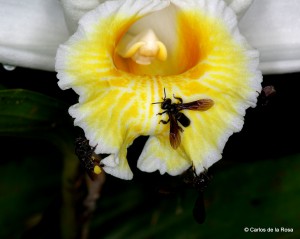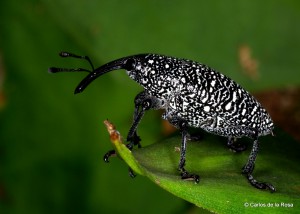 “Knock-knock!” Don’t say “Who’s there?” It is not a knock-knock joke. Someone knocks at my office door with regularity these days. I open and, invariably, it is one of my staff, or a researcher, or a graduate student, saying “Carlos, do you want to see something cool? Bring your camera!”
“Knock-knock!” Don’t say “Who’s there?” It is not a knock-knock joke. Someone knocks at my office door with regularity these days. I open and, invariably, it is one of my staff, or a researcher, or a graduate student, saying “Carlos, do you want to see something cool? Bring your camera!”
So the word is out. I take decent pictures and I’m for sale, cheap, at a moment’s notice. I’ll drop whatever I’m doing for an insect, a lizard, a particularly fresh or rare orchid, a fungus or a fungus gnat. Today, for example, after a massive downpour that started around 4 a.m. and lasted until mid-morning, the grounds are soaked, pregnant with water, rivulets running through the field station’s landscape. The river is swollen, milk-chocolate brown, and dense. And in the dripping forest, lots of things are happening. This last call was to see a nest of Nasutitermes termites, the ones where the soldiers have dark, pointy heads that squirt formic acid to potential threats. The rains had dislodged the backpack-sized nest from the tree where it was attached, prompting a mass exodus of soldiers and workers. But it also coincided with the massive exit of the new queens, with their long, brown, silky and delicate wings, spreading their colony’s genes as far and as wide as their wings will take them. They pour out of the lumpy nest in droves, feebly taking flight while the workers attempted to repair the catastrophic fail of the next supports, and the soldiers, well, soldiered on. But not all is well…
A rare yellow-spotted tropical night lizard, Lepidophyma flavimaculatum, sat, uncharacteristically, in broad daylight feasting on the emerging queens, calmly reaching out and slapping one with her tongue, swallowing, and waiting for the next hapless queen to wander close to her face. Her head, her whole body, was covered with soldiers, futilely attempting to make it retreat. These lizards are generally parthenogenetic (meaning, they reproduce without males, which is why I called it a “she”), have heads that resemble that of a snake, and can bite pretty hard with their black, sharp teeth.
A small crowd gathers around the nest at the base of the tree, shooting natural history tidbits about the termites, the lizard, the tree they’re on and more, while I kneel, crawl and get myself mucky looking for the best angles and wish I had four hands so I could also write and collect all of the amazing information these people are spewing off conversationally as if talking about the weather. I’m surrounded by bio-geeks and I’M LOVING IT! Another day, another cool species, another change of clothes.
This last week, between meetings, memos and proposals, I’ve seen some spectacular forest jewels, which I had the pleasure and the fortune to photograph, in the wild and at their best. One of the knock-knocks I responded to was to show me a rhinoceros beetle, which had been attracted to the lights on the lab’s porch. This species, together with Megasoma elephas (the gigantic elephant beetle) and a Cerambicidae (long-horned beetle) with large and sharp mandibles that tasted blood from my finger, made for a “elefantastic” evening of huge insects. I only wait now for the call to see the harlequin beetle (Acrocinus longimanus), the largest bettle of them all (in size, because in weight, the elephant beetle has them beat) which is here, but I have not run into yet.
Another knock-knock, this time from the wife of one of our resident biologists. “Carlos, want to photograph this?” In her hand “This” materialized as an enormous leaf or hooded mantis, Choeradodis rhombicollis, no less than 5 inches long, and resembling a split-leaf, rotting and lichen spots and all. It had a thick, heavy body, front legs adapted for grabbing prey, sharp with spines and interesting black markings, like shiny tar. Under the perfect leaf camouflage, its flying wings were yellow and bright red, yet another way to defend itself from potential predators by a sudden display of warning colors.
Perhaps the most fabulous encounter of the week was one experienced by Jay Ireland, a film-maker, diver and adventurer extraordinaire, visiting La Selva to support our volunteer programs. His very expensive camera broke down on the very first day of his visit, so he made lemonade out of this huge lemon, by walking around taking pictures and making sound recordings on his iPhone. On a drippy Thursday night, at 3 a.m., he walked to the Cantarrana swamp I had showed him the day before, looking to record the sounds of frogs and crickets, and ran into a young ocelot (Leopardus pardalis) hunting frogs in the grassy swamp. For over 15 minutes, Jay and the ocelot watched each other, immortalized by the recording on the iPhone by the light of a flashlight.
These days feel like I’m in a forested dream, a fantasy of dripping forests, extraordinary creatures, like the stunning helicopter damselfly (Megaloprepus coerulatus) sitting on a tiny branch, allowing me to come within a few inches of its jeweled wings; or the magnificent white and yellow show of the Sobralia orchids, blooming spectacularly one day, gone the next day. I photographed several black bees visiting the flowers, slowly collecting pollen, seemingly drunk in the aroma and bounty offered within the yellow-stropped chambers. Or, in contrast, the diminutive Ionopsis utriculariodes orchid, so small it can easily be missed and it doesn’t even have a common name. I wonder what visits its flowers in the immensity of the forest where it lives. Or the male yellow-headed gecko (Gonatodes albigularis), with its orange and white face that sat on the wall inside the house and allowed me to take photo after photo without concern. And so on.
Every day bring s with it an encounter, a discovery, an unusual event. Students and researchers, staff and visitors come back to the busy dining hall at meal times telling about their own fabulous encounters with wildlife that most people will only see in books. This is perhaps the magic of the tropical rain forest. It is a never-ending show, with thousands of actors, all playing very specific roles, in the grandest stage one can imagine. The tropical rainforest, its apparently inexhaustible richness and spread, is in reality a dwindling and disappearing ecosystem, preserved forever in a few places like La Selva, literally awaiting to be rediscovered and revalued by a society that seem to have lost its way. We have a lot to share and a lot to save. “Knock-knock! Want to see something that will change your life? Come out and see this…”
s with it an encounter, a discovery, an unusual event. Students and researchers, staff and visitors come back to the busy dining hall at meal times telling about their own fabulous encounters with wildlife that most people will only see in books. This is perhaps the magic of the tropical rain forest. It is a never-ending show, with thousands of actors, all playing very specific roles, in the grandest stage one can imagine. The tropical rainforest, its apparently inexhaustible richness and spread, is in reality a dwindling and disappearing ecosystem, preserved forever in a few places like La Selva, literally awaiting to be rediscovered and revalued by a society that seem to have lost its way. We have a lot to share and a lot to save. “Knock-knock! Want to see something that will change your life? Come out and see this…”
Carlos de la Rosa

Recent Comments